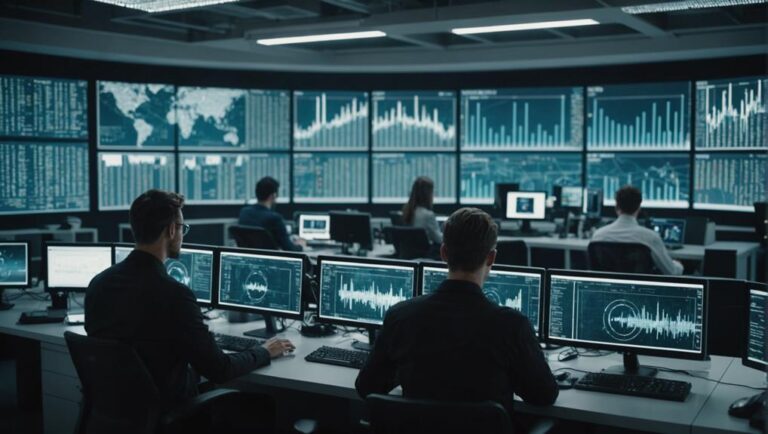Integration Challenges in Technology Due Diligence for M&A

During technology due diligence for M&A transactions, we encounter numerous integration obstacles. It is crucial to identify early on the compatibility of IT infrastructures, as legacy systems often present risks to the integration process.
Ensuring compliance with data security and privacy regulations is paramount to protect sensitive information from breaches. Thorough harmonization of software applications and the implementation of robust data migration strategies are necessary to prevent any disruptions in operations.
Effectively managing technological changes while upholding security standards is of utmost importance during the integration phase. Aligning the adoption of new technologies with the organizational culture can enhance employee engagement and boost productivity levels.
Proactively assessing cybersecurity risks and strategically managing budgets are essential for ensuring a smooth integration process. Legal and regulatory considerations must be diligently addressed to mitigate any potential compliance issues.
A well-defined communication strategy is vital for keeping stakeholders aligned and informed about the progress of the integration. By addressing these challenges head-on and implementing strategic solutions, companies can navigate the complexities of technology integration in M&A transactions successfully.
Key Takeaways
- Outdated systems present substantial compatibility issues and cybersecurity vulnerabilities during the merger and acquisition consolidation process.
- Conducting a thorough evaluation of data security and privacy compliance is essential to safeguard confidential information.
- Implementing effective strategies for data migration is crucial to minimize data loss and maintain data integrity.
- Utilizing strong project management frameworks is key to facilitating seamless coordination among diverse technology platforms.
- Maintaining open and clear communication with stakeholders helps to reduce resistance and ensure alignment of expectations throughout the integration phase.
IT Infrastructure Compatibility
When evaluating IT infrastructure compatibility in M&A transactions, legacy systems and diverse technology stacks can present significant challenges. The presence of different technology stacks, ranging from outdated software to incompatible hardware setups, often complicates the process of seamless integration. These disparities require careful planning and execution to overcome.
Thorough IT due diligence is crucial in identifying potential compatibility issues early on. By examining all aspects of the current IT infrastructure, we can pinpoint areas that may pose integration challenges. Taking a proactive approach enables us to develop strategies to tackle these issues, whether through upgrading legacy systems or implementing innovative solutions to bridge technological gaps.
Legacy systems, which are often outdated and unsupported, may require substantial upgrades to align with modern standards. Addressing these issues in the initial stages of the M&A process can help mitigate risks and streamline the integration process. By being prepared to address these challenges upfront, we can enhance the chances of successful integration.
Understanding the complexities of IT infrastructure compatibility is essential for a successful M&A transaction. Thorough due diligence and readiness to tackle integration challenges put us in a better position to drive innovation and achieve strategic objectives effectively.
Data Security Compliance
Ensuring data security compliance in M&A transactions is crucial for safeguarding sensitive information and complying with regulations like GDPR and HIPAA. Evaluating data protection mechanisms and privacy policies diligently is key in this process. Understanding a company's approach to data security and regulatory compliance helps mitigate risks, ensuring the security of sensitive information throughout the integration process.
Legacy systems often present significant security challenges, necessitating proactive assessment and resolution. By examining these systems, potential vulnerabilities that could compromise data security can be identified and addressed. This not only safeguards data but also ensures adherence to regulatory standards, preventing legal and financial consequences.
A comprehensive review of privacy policies is essential to ensure alignment with current regulations and establish a robust framework for data protection. This assessment helps pinpoint areas that require improvement, guaranteeing the implementation of strong data security measures.
Software Application Harmonization
When considering software application harmonization in the context of mergers and acquisitions, it's crucial to prioritize robust data migration strategies, comprehensive compatibility assessments, and precise integration timeline management. These aspects are pivotal in ensuring the seamless operation of the combined entities' software systems. By carefully planning and executing these steps, organizations can steer clear of common pitfalls and establish a more efficient and cohesive IT environment.
In the realm of M&A technology due diligence, conducting a thorough evaluation of software systems and their compatibility is essential to avoid disruptions and ensure a smooth transition. By meticulously assessing the technical aspects and functionalities of the existing applications, organizations can better understand the complexities involved in integrating different systems. This proactive approach helps in identifying potential challenges early on and devising effective strategies to address them.
Effective data migration strategies are paramount during the harmonization process, as they determine how information is transferred and integrated across the merged entities. By employing advanced data migration tools and techniques, organizations can minimize data loss, ensure data accuracy, and maintain data integrity throughout the transition. This meticulous approach not only enhances operational efficiency but also safeguards against potential data security risks.
Managing the integration timeline with precision is another critical factor in software application harmonization. By setting clear milestones, allocating resources effectively, and continuously monitoring progress, organizations can stay on track and meet key objectives within the specified timeframe. This structured approach enables a smooth transition and minimizes disruptions to business operations, ultimately leading to a successful integration of software systems.
Data Migration Strategies
Effective data migration strategies are crucial for aligning software applications during M&A transactions, ensuring data integrity and operational efficiency. Thorough planning is essential to successfully transfer data from legacy systems to new platforms while maintaining accuracy and preventing loss or corruption. This process involves meticulous data mapping and cleansing, which are critical steps in preserving the reliability and precision of our data.
By leveraging advanced data migration tools and technologies, we can streamline the process, minimize disruptions, and facilitate smooth integration. These tools automate and manage the migration, reducing manual errors and safeguarding the integrity of the data throughout the transition.
Successfully harmonizing software applications through robust data migration strategies is essential for optimizing operational efficiencies and leveraging synergies post-M&A. It enables the seamless consolidation of disparate systems, creating a unified platform that aligns with our business objectives.
Here's an overview of our approach:
| Step | Description |
|---|---|
| Planning | Develop a comprehensive migration plan. |
| Data Mapping | Identify and map data from the old to the new systems. |
| Data Cleansing | Eliminate inaccuracies and inconsistencies. |
| Migration Tools | Implement advanced tools for efficient data transfer. |
Compatibility Assessment Techniques
Assessing software compatibility in mergers and acquisitions is pivotal for seamless integration and operational efficiency. It's imperative to evaluate integration challenges related to software systems, databases, and interfaces to ensure effective communication between disparate applications and smooth data flow. This process, termed software application harmonization, is crucial for maximizing the benefits of a merger or acquisition.
One key technique we utilize is API compatibility testing, which helps verify the ability of different software systems to interact through their application programming interfaces. By confirming API compatibility, we establish a cohesive environment conducive to seamless data exchange.
Another essential method is data mapping, which involves identifying the correspondence between data elements in different systems. Effective data mapping guarantees accurate data transfer and interpretation, reducing the risk of data loss or corruption.
Lastly, a comprehensive analysis of system architecture is conducted to comprehend the underlying structures of the software systems and pinpoint potential integration points. By meticulously addressing these aspects, a harmonized software environment can be achieved, fostering operational efficiency and encouraging innovation post-merger.
Integration Timeline Management
To ensure a seamless transition while managing the integration timeline for software application harmonization, it is crucial to employ effective project management techniques and well-thought-out integration strategies. The first step is to establish a realistic timeline that aligns with the post-merger integration objectives. This includes streamlining systems, data, and processes to create a cohesive and optimized software environment. Overcoming authentication challenges and simplifying user logins are essential for maintaining operational continuity.
A structured approach aids in mitigating risks and reducing disruptions. By embracing agile methodologies, we can swiftly adapt to any obstacles that may arise, ensuring that our timeline stays on course. Our integration strategies should be adaptable, allowing for incremental enhancements as we merge different software applications.
The integration timeline could be structured as follows:
| Phase | Duration | Key Activities |
|---|---|---|
| Initial Assessment | 1-2 months | System evaluations, data mapping |
| Execution | 3-6 months | System integration, data transfer |
| Refinement | 2-4 months | Fine-tuning, addressing user inputs |
Technology Transition Management
Effective due diligence is a critical aspect of mergers and acquisitions (M&A) in the realm of technology. It serves as the foundation for a successful transition from existing IT systems to new integrated platforms post-M&A. Technology change management plays a pivotal role in ensuring a seamless and efficient integration process. By meticulously planning each phase of the transformation, organizations can address complexities head-on and minimize disruptions.
To delve deeper into the essential elements of effective technology change management, we must prioritize several key factors:
- Minimize Disruption: The primary goal is to ensure that daily operations continue smoothly throughout the transition. Identifying and addressing potential points of failure is crucial to maintaining business continuity.
- Maintain Security Standards: Safeguarding sensitive data and upholding robust cybersecurity measures are paramount during the integration process. Adhering to stringent security protocols is non-negotiable to protect valuable information.
- Consolidate Data Systems: Seamless integration of disparate data systems is essential to ensure data coherence and accessibility. By consolidating data systems effectively, organizations can enhance operational efficiency and decision-making processes.
- Optimize Operations: Streamlining workflows and eliminating redundancies can significantly improve overall performance post-M&A. By optimizing operations, organizations can enhance productivity and drive business growth.
- Leverage Expert Guidance: Engaging with IT integration specialists can provide valuable insights and support throughout the transformation process. Collaborating with experts in the field can help organizations navigate challenges and achieve a smoother transition.
In the context of M&A technology due diligence, these elements play a crucial role in facilitating a successful integration process and ensuring long-term business success. By focusing on minimizing disruptions, maintaining security standards, consolidating data systems, optimizing operations, and leveraging expert guidance, organizations can navigate the complexities of technology transitions post-M&A effectively.
Cultural Technology Adoption
Adopting cultural technology is crucial to seamlessly integrate new technologies into an organization's cultural framework. Understanding cultural differences is key during the integration process. Each organization has distinct cultural norms and values that impact how technology adoption unfolds. Aligning technology use with these cultural beliefs, behaviors, and practices is essential for a smooth transition.
The focus should be on how employees interact with technology, adapt to changes, and integrate these tools into their daily work routines. This approach not only reduces potential obstacles but also creates a more inclusive environment conducive to innovation. Companies that effectively manage cultural technology adoption typically experience increased employee engagement and productivity. These organizations establish a foundation where technology isn't just introduced but embraced and maximized.
In the realm of mergers and acquisitions (M&A), conducting thorough technology due diligence is paramount. This process involves assessing the target company's technological capabilities, infrastructure, and systems. By delving into these aspects, acquirers can identify potential risks, opportunities, and synergies. Technology due diligence in M&A helps mitigate integration challenges and ensures a smoother transition for all involved parties.
Resistance to Change
In the realm of mergers and acquisitions (M&A), the process of integrating technology can be met with resistance from employees. This resistance stems from various factors that can impede the smooth transition of technology.
Fear of job losses often arises when automation and integration are introduced, creating anxiety about the security of one's position within the company. Additionally, cultural misalignment between organizations can lead to clashes that hinder the acceptance of new technologies.
Insufficient training on newly implemented technologies can also contribute to confusion and resistance among employees. Change fatigue, a feeling of being overwhelmed by constant changes, can further reduce employees' willingness to adapt to new systems. Communication gaps regarding the benefits and procedures of technology integration can lead to mistrust and resistance among the workforce.
To address these challenges, a robust change management strategy is essential during M&A technology integration. Effective communication and comprehensive training programs play a crucial role in mitigating resistance. It's imperative to emphasize the positive impacts of technology integration, reassuring employees about their roles and the benefits that these changes bring to their work environment.
Technological Maturity Levels
Assessing technological maturity levels is crucial for gauging the readiness of IT systems for integration post-M&A. During technology due diligence, we analyze the maturity levels of the systems involved, spanning from fundamental infrastructure to advanced digital transformation capabilities. This assessment aids in devising integration strategies efficiently and identifying any gaps that require attention.
Understanding the maturity levels enables us to make well-informed decisions regarding system consolidation and necessary technology upgrades. Mature technologies facilitate smoother integration processes, thereby boosting operational efficiency—a pivotal aspect for the success of any merger or acquisition. It's imperative to determine if the target company's IT framework is robust enough to seamlessly merge with our own or if significant enhancements are needed.
Furthermore, evaluating technological maturity levels allows us to anticipate potential obstacles and proactively devise solutions. The higher the maturity of the technology, the less friction encountered during integration. It isn't solely about possessing state-of-the-art systems; rather, it pertains to how prepared those systems are for the inevitable challenges of merging two distinct IT environments.
Hence, a comprehensive maturity assessment isn't just a mere step in due diligence—it is a critical element in ensuring a seamless transition and future-proofing our technological infrastructure.
Project Management Challenges
Understanding the levels of technological maturity is crucial in tackling the project management hurdles that surface during technology integration in M&A deals. Effective project management plays a pivotal role in attaining the desired financial outcomes and ensuring a smooth technology integration process. However, numerous challenges can hinder progress.
M&A projects are often characterized by their complexity and the need for seamless coordination among multiple technology systems and stakeholders, presenting a significant challenge. Integration timelines are frequently impacted by dependencies on other workstreams, leading to potential delays in the overall project.
Balancing technology integration with ongoing business operations is essential for maintaining business continuity and avoiding disruptions. Employing a well-defined project management framework is crucial but can be challenging to implement consistently across diverse teams. Delays and mismanagement in project execution can have a direct financial impact, undermining the anticipated synergies from the M&A deal.
To overcome these obstacles, meticulous planning and robust coordination are essential. Implementing a flexible yet structured project management framework can streamline the technology integration process, ensuring minimal disruption to business operations and achieving excellent financial outcomes. By anticipating these challenges and preparing adequately, organizations can transform potential hurdles into opportunities for innovation and growth, ensuring the M&A deal meets its strategic objectives.
Cybersecurity Risks
When discussing cybersecurity risks in the context of M&A deals, it's crucial to acknowledge that merging IT infrastructures inherently exposes vulnerabilities that cybercriminals eagerly exploit. The integration of two distinct systems can unveil gaps that were previously unseen, potentially creating security weaknesses. These gaps present lucrative opportunities for cybercriminals seeking to perpetrate data breaches or other harmful activities.
The uncertainty and lack of clarity that often accompany the integration phase exacerbate these cybersecurity risks. When teams are unsure about the status of their IT environments, unauthorized access becomes more likely. Therefore, prioritizing cybersecurity right from the onset of the consolidation process is vital. By taking proactive measures, we can identify and address potential vulnerabilities before they escalate into significant threats.
Furthermore, the revelation of vulnerabilities through the combination of IT infrastructures poses a significant cybersecurity risk in M&A transactions. It goes beyond simply merging systems; it's about ensuring the resilience and security of the integrated system. Thorough cybersecurity assessments and stringent security protocols must be implemented to safeguard sensitive data.
Integrating cybersecurity into our M&A strategy is essential for protecting against the constantly evolving landscape of cyber threats, guaranteeing a smooth and secure merger.
Budget Management
When managing the budget for technology due diligence in mergers and acquisitions, it's crucial to prioritize cost control measures, allocate resources strategically, and assess financial risks carefully.
By planning and monitoring expenditures diligently, we ensure that our financial resources are utilized efficiently to meet integration objectives.
This approach enables us to mitigate risks and prevent unexpected costs that could potentially undermine the success of the M&A transaction.
Cost Control Measures
Cost control measures play a crucial role in managing the budget during technology integration in M&A transactions. Establishing clear budgetary guidelines is key to prevent overspending and maintain financial discipline throughout the integration process. Effective budget management not only reduces financial risks but also boosts the overall success of technology integration efforts.
To ensure we stay on budget, it's important to closely monitor and track expenses. This allows us to stay within budget constraints and achieve our desired outcomes. Adhering strictly to established budgetary guidelines helps us steer clear of financial pitfalls. Regular financial reviews should be implemented to identify potential overspending early on, enabling timely adjustments. Leveraging advanced budget management tools can enhance accuracy and visibility in financial tracking. Involving stakeholders in budget discussions is also crucial to ensure alignment with financial goals and constraints.
Adhering to these cost control measures enables efficient resource allocation, maximizing the return on investment in technology integration. By closely monitoring expenses and maintaining strict budget management, financial risks can be mitigated, leading to a successful M&A technology integration.
Proactive financial oversight is essential for a smooth, efficient, and cost-effective integration process.
Resource Allocation Strategies
Strategic resource allocation is crucial for effectively managing the budget and ensuring successful technology integration in M&A transactions. Precision in our resource allocation approach is key to navigating the complexities of legacy system compatibility and data integration. By managing our budget effectively, we can align technology integration efforts with our overarching M&A objectives and financial constraints.
It is essential to prioritize allocating resources to critical areas such as data migration, system integration, and talent retention to address potential cybersecurity vulnerabilities and minimize operational disruptions. A well-structured budget management plan allows us to invest in essential technologies and skilled personnel, which are critical for seamless technology integration.
Furthermore, strategic resource allocation aids in mitigating integration risks. Efficient allocation of resources enables us to focus on resolving technology challenges without exceeding budget limits, supporting smooth technology integration and strengthening our financial position during the M&A process.
Financial Risk Assessment
When conducting due diligence in mergers and acquisitions, it's crucial to assess budget management strategies to ensure alignment between technology integration goals and financial capabilities. This evaluation helps in mitigating financial risks and optimizing cost-effectiveness, ultimately leading to a successful integration process.
By carefully examining the financial implications of technology integration, organizations can identify constraints and opportunities for optimization.
To start, it's essential to evaluate the current allocation of budget funds. This analysis provides insights into areas that may require reallocation to support the integration process effectively. By understanding how funds are currently distributed, organizations can make informed decisions on resource allocation.
Analyzing cost-benefit scenarios is another key step in the process. By weighing the costs against the expected benefits of technology integration, organizations can make strategic decisions that align with their financial goals. This helps in ensuring that financial resources are utilized efficiently and effectively.
Identifying financial constraints early on is critical in developing realistic integration plans. By recognizing potential limitations, organizations can proactively address challenges and find solutions to ensure a smooth integration process. This proactive approach helps in minimizing risks and maximizing the value of the integration.
Optimizing resource utilization is essential for cost-effectiveness. By efficiently using available resources, organizations can minimize waste and maximize value, ultimately leading to a more successful integration process. This optimization ensures that resources are allocated strategically to support the organization's goals.
Developing a contingency plan is also important in preparing for unforeseen expenses. By being proactive and planning for unexpected costs, organizations can remain adaptable and resilient during the integration process. This preparedness helps in minimizing disruptions and ensuring a smooth transition post-M&A.
Legal and Regulatory Considerations
Understanding the legal and regulatory landscape in technology due diligence for M&A requires a deep understanding of compliance with standards such as HIPAA and GDPR. We must carefully assess data privacy governance to ensure that the mechanisms for data protection and user privacy are strong and up to date. Legal implications can arise when evaluating the IT environment, and our goal is to verify that all systems adhere to current security protocols.
Compliance standards are essential, and we must closely examine legacy systems. Identifying outdated software or hardware, along with the associated risks and potential costs, is vital. This process helps us grasp the legal consequences of integrating these systems and ensures that we can meet all required regulations.
Furthermore, it's crucial to review Business Continuity and Disaster Recovery (BCDR) policies for effective crisis management. These policies should align with regulations like HIPAA and GDPR to guarantee that data remains secure even during challenging situations.
Our approach to legal and regulatory considerations in technology due diligence focuses on foresight and thorough evaluation. By understanding these complexities, we can navigate potential challenges and ensure a smooth M&A process that complies with all legal standards.
Stakeholder Communication
In technology due diligence for mergers and acquisitions, having a well-defined messaging strategy is crucial to ensure all stakeholders are aligned on integration goals and timelines.
Transparent communication is key to managing expectations, reducing resistance, and promoting collaboration.
Providing regular updates and soliciting feedback can improve decision-making and enable effective progress tracking throughout the process.
Clear Messaging Strategies
When dealing with technology due diligence in mergers and acquisitions, it's crucial to have a well-defined communication strategy that aligns all stakeholders on the integration's purpose, timeline, and expectations. Clear messaging strategies play a vital role in stakeholder communication as they ensure transparency, reduce resistance, and promote collaboration in addressing technology challenges effectively. This transparency is key to creating an environment where everyone feels informed and engaged, leading to a successful technology integration process.
To achieve this, our strategy should focus on the following key elements:
- Regular Updates: Providing timely progress reports keeps stakeholders informed about milestones and potential obstacles that may arise.
- Feedback Channels: Open avenues for feedback enable us to address any concerns promptly and make necessary adjustments.
- Detailed Progress Reports: Sharing comprehensive reports on each integration phase helps everyone grasp the current status and understand the next steps.
- Open Communication: Maintaining transparent communication channels fosters trust and minimizes disruptions throughout the integration process.
- Tailored Messaging: Crafting clear, concise messages tailored to the specific needs of each stakeholder group ensures that everyone understands their role and contribution to the integration process.
Alignment of Expectations
Ensuring stakeholders are on the same page is crucial for a seamless technology integration process during mergers and acquisitions. Clear and effective communication is key to ensuring that everyone understands the outcomes of the due diligence process, the challenges ahead, and the timelines involved. By providing straightforward information, we can address concerns and establish realistic expectations.
Engaging stakeholders in decision-making and planning is essential for successful integration. When stakeholders feel listened to, it fosters collaboration and reduces resistance. Transparently discussing the integration process, including both potential obstacles and advantages, helps create a sense of ownership and dedication among all parties involved.
Regular updates are vital to keeping everyone in the loop. Consistent communication ensures that everyone stays informed and involved, preventing misunderstandings that could hinder the integration progress. Addressing concerns promptly and sharing regular updates helps to maintain alignment and support from stakeholders throughout the process.
Frequently Asked Questions
What Are the Challenges of Acquisition Integration?
Acquiring companies often encounter challenges such as the need for thorough cultural alignment, overcoming communication barriers, and navigating leadership changes. These obstacles can impede the progress of innovation, hinder effective team integration, complicate decision-making processes, and potentially impact overall morale throughout the acquisition journey. Embracing and adapting to change is crucial for achieving success in the midst of these challenges.
What Are Three Major Challenges That Firms Integrating Acquisitions Are Likely to Face?
Facing challenges in aligning cultures, maintaining leadership continuity, and retaining key talent are common hurdles during the integration of acquisitions. Harmonizing disparate work cultures, ensuring consistent leadership presence, and retaining top performers are critical for fostering innovation post-acquisition.
Engaging in thorough due diligence in mergers and acquisitions can mitigate these challenges. By conducting a comprehensive assessment of the target company's cultural norms, leadership structure, and talent pool, acquiring firms can proactively address potential integration issues.
Utilizing advanced technology tools for M&A due diligence can provide valuable insights into the cultural compatibility, leadership capabilities, and talent retention strategies of the target company. Leveraging data analytics and artificial intelligence can streamline the due diligence process and identify red flags that may impact post-acquisition integration efforts.
Incorporating a technology-driven approach to M&A due diligence can enhance decision-making and improve the likelihood of successful integration outcomes. By leveraging data-driven insights, acquiring firms can navigate the complexities of cultural alignment, leadership continuity, and talent retention more effectively.
What Is Integration Due Diligence?
Just like a skilled conductor leading an orchestra, integration due diligence in mergers and acquisitions involves evaluating synergies, aligning cultures, and mitigating risks. This process ensures that our IT systems work together seamlessly, data is transferred smoothly, and cybersecurity measures are robust, setting the stage for future innovation in our organization.
What Is the Due Diligence of Technology?
During technology due diligence in mergers and acquisitions, we analyze existing systems, proprietary technology, and contractual agreements with suppliers. This process allows us to pinpoint potential pitfalls, evaluate the capacity for growth, and harmonize technological resources to foster innovation and facilitate seamless integration after the merger or acquisition.
The examination of legacy systems helps us understand the technological foundation of the target company and assess its compatibility with our own infrastructure. By delving into the intellectual property portfolio, we gain insights into the unique assets and innovations that could drive future growth and competitive advantage. Additionally, reviewing vendor contracts enables us to identify any potential liabilities or dependencies that may impact the post-merger integration process.
Conclusion
When managing technology due diligence for M&A, it's crucial to align IT infrastructure, ensure data security compliance, and oversee technology changes.
Effective stakeholder communication plays a key role in bridging the gap between cultural adoption and cybersecurity risks.
By addressing these elements thoroughly, we can streamline budget management and adhere to legal and regulatory considerations.
Our expertise in this area ensures a seamless integration that mitigates risks and maximizes the value of the merger or acquisition.





